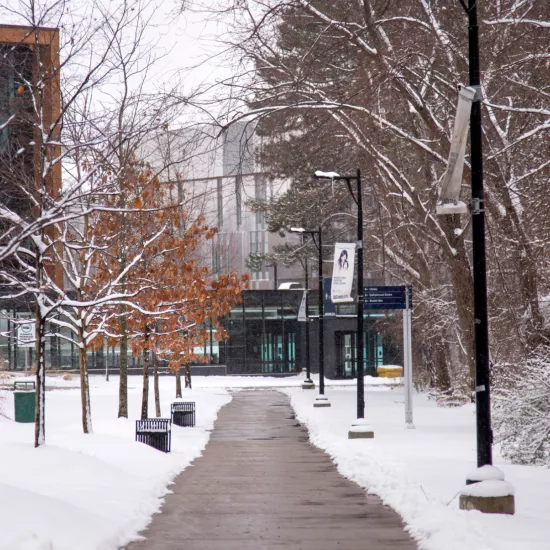How Strategic Peak Demand Management Leads to Big Cost Savings for UTM: An Explainer

The University of Toronto Mississauga (UTM) is making progress towards our Climate Positive Plan target of reducing greenhouse gas (GHG) emissions by 39 percent by 2030, carbon neutrality by 2043, and climate positive by 2050. One of our campus's key strategies to reduce energy consumption is through strategic Peak Demand Management, which has led to a reduction of carbon emissions and energy use while saving money for the university. But what is strategic demand management, and how does it work for our campus?
Electricity Costs and Grid Peaks
Strategic demand management is the monitoring and adjustment of a facility’s electricity use to manage costs and emissions. Nearly 50% of UTM’s annual electricity costs are based on how much energy UTM uses when the demand on the Ontario electricity grid is highest, which is typically on hot summer days. Reducing electricity use on these peak days leads to significant cost savings and reduces consumption when the electricity grid emits the most carbon.
Peaks occur on different days each year, so an effective demand response initiative must be able to predict and respond to grid conditions. If a facility can shut off or turn down systems, such as air conditioning or lighting, on a hot summer day, it can significantly reduce its electricity costs.
Impacts of Demand Management Strategy
UTM has taken an active approach in reducing electricity costs: over the past three years UTM achieved 17,000 kW reduction in peak-time energy use, amounting to 15 tonnes of carbon reduction and generating more than $1.6 million in bottom-line savings.
Over the past year, the days with the highest grid demand occurred in July and early September. UTM was successful in predicting these peak hours, and by implementing a demand management strategy, it led to $394,600 in avoided costs for the university. The table below shows the estimated savings from 2021 to 2023.
Table 1 – Estimated Savings over the Last Three Years
Year | Estimated Savings ($) |
May 2021-April 2022 | 739,100 |
May 2022-April 2023 | 507,500 |
May 2023-April 2024 | 394,600 |
What Happens on a Peak Day?
On a potential peak day, the UTM operations and sustainability teams receive an email alert from a peak tracking service on the likelihood of a grid peak and the four-hour window in which it is expected to occur. The operations team then implements a list of demand reduction measures including:
- Increasing temperature setpoints by a few degrees to reduce cooling requirements
- Lowering blinds on large windows
- Adjusting the tint on electrochromic windows in Davis building
- Decreasing fan speeds for large air handling units
While there is some increase in indoor temperatures during a demand reduction window, it is typically limited to the late afternoon as occupants are beginning to leave campus.
What’s Next?
Overall, UTM has been successful in predicting yearly peaks; however, it is clear we can be more aggressive in our strategy to mitigate costs and save energy. By educating the UTM community about peak demand management and outlining the steps they can take to participate, we can ensure UTM is a leader in the province. The proposed approach for 2024-2025 is to target a demand of 5MW, which is the lowest demand during a peak that UTM has reached and represents about a 20% reduction on any given peak day. Figure 1 shows UTM and grid demand during peaks for the past 5 years. For the current period, the province has already experienced several potential peak days, which the campus has responded to. However, going forward, an email will be sent out to listserv subscribers to be informed of potential peaks.
How can the UTM Community get involved?
The UTM community will play a significant role in demand reduction and in reaching the Climate Positive goals. Ahmed Azhari, Managing Director - Operations, Sustainability and Asset Management states that “We all play a part in reducing UTM’s energy consumption and carbon footprint and there are many ways students, faculty, librarians, and staff can be involved with accelerating our energy conservation efforts.”
Small acts of conservation by our building occupants can impact energy consumption by as much as 15%. Most electronics and light fixtures not only draw energy, but they also create ambient heat, further taxing air conditioning. Here are some ways that you can help to reduce UTM’s energy use year-round, and take extra steps on the highest energy demand days:
- Sign up for notifications about peak demand days from the Sustainability Office. We will share specific information about anticipated peak energy demand times and share information about how you can take energy conservation action during your workday on campus.
- Unplug research loads that do not need to be working during the night
- Shut down non-essential equipment (coffee makers, printers, desk lamps, monitors, fans, etc.)
- In days of extreme heat, keep windows, curtains and blinds closed to prevent your space from warming up
- Turn off lights when leaving a room or when you notice an unoccupied space with lights on
- Wear lightweight clothing to stay cool and comfortable while indoor climate control is reduced
- Keep hydrated. Visit one of UTM’s water stations throughout the day
For more details on how UTM is striving towards building a sustainable future, check out these Plans below:

Figure 1 - UTM’s Participation in the ICI: 2018-2024



